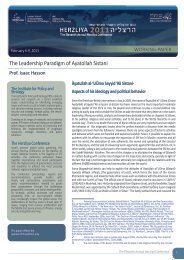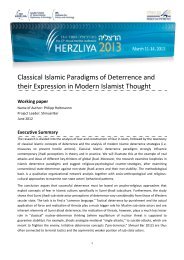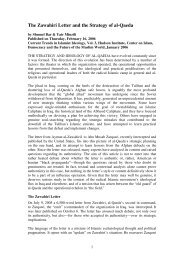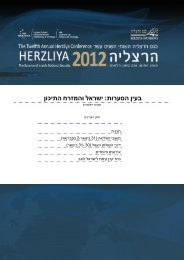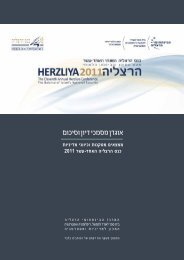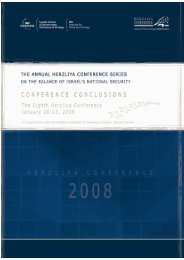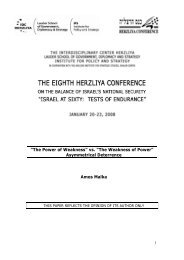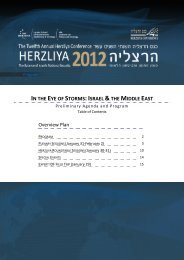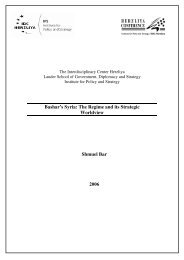Iran: Cultural Values, Self images and Negotiation Behavior
Iran: Cultural Values, Self images and Negotiation Behavior
Iran: Cultural Values, Self images and Negotiation Behavior
Create successful ePaper yourself
Turn your PDF publications into a flip-book with our unique Google optimized e-Paper software.
<strong>Iran</strong>: <strong>Cultural</strong> <strong>Values</strong>, <strong>Self</strong>-<strong>images</strong> <strong>and</strong> Negotiating <strong>Behavior</strong>considerations <strong>and</strong> plans of the leadership; or the underlying <strong>Iran</strong>ian view of the worldas a concatenation of transient <strong>and</strong> ephemeral conditions, which may, upon theirchange, render any written agreement irrelevant. 147Risk PropensityThe <strong>Iran</strong>ian tendency towards pessimism <strong>and</strong> conspiracy <strong>and</strong> the ingrained mistrustof the “other,” create an exaggerated view of the significance of any concessions.Seeing themselves as under attack, <strong>Iran</strong>ian negotiators tend to be in a defensive modeof minimizing losses <strong>and</strong> not necessarily maximizing gains: negotiations are not bornof opportunity, but of necessity, since one would not normally negotiate from aninferior position (as the <strong>Iran</strong>ian normally sees himself). As a result, <strong>Iran</strong>ian riskpropensity – willingness to hold out for better terms – tends to be higher than Westernnegotiators, who are frequently focused on maximizing gains. 148The Bargaining ZoneThe permanent <strong>Iran</strong>ian sense of inferiority vis-à-vis the West tends to cause <strong>Iran</strong>iannegotiators to resist Western attempts to bring in extraneous issues. At the same time,however, it is the cause of the <strong>Iran</strong>ian tendency to look for additional areas <strong>and</strong> issuesof potential Western risk, in order to widen the scope of issues that they can useagainst the West. This is different than the traditional concept of exp<strong>and</strong>ing the pie inorder to reach a more equitable deal. 149An example of this strategy can be seen in the <strong>Iran</strong>ian signals during 2003 of awillingness to restrain the Lebanese Hezbollah <strong>and</strong> support the Western war againstterrorism (including arrests of Al Qaeda activists who crossed into <strong>Iran</strong> fromAfghanistan). The <strong>Iran</strong>ian side perceived these issues are central to U.S. interests <strong>and</strong>proposed “tension reduction steps.” 150 In practice, <strong>Iran</strong> is exp<strong>and</strong>ing the pie of criticalnegotiations over its nuclear program to include other urgent issues, hoping toimplement a trade-off between the two areas.147 Picco related a meeting with the <strong>Iran</strong>ian negotiator Ali Larijani, at the end of which Picco drew up aprotocol <strong>and</strong> asked the <strong>Iran</strong>ian to sign it. Larijani refused, though he did not claim that what wasdescribed in the document was incorrect. When he finally agreed, under pressure, to sign, he made itclear that the document “only describes a situation which existed at a certain moment in the talks. Themoment it is signed, conditions have changed <strong>and</strong> it may be worthless.” In other cases, <strong>Iran</strong>ians haverefused to sign documents, claiming that “the only written document which is binding is the Koran.”Rafsanjani himself referred to the international conventions on WMD as “pieces of paper” which maybe torn up when the situation dictates.148 This seems to fit the Tversky-Kahnemann paradigm of people being risk-averse for gains <strong>and</strong> riskseeking for losses. In the <strong>Iran</strong>ian case, since political negotiations with the West are almost alwaysdefensive, (i.e., about potential losses) the <strong>Iran</strong>ian side will tend to be risk seeking, <strong>and</strong> averse toconcessions.149 See Thompson 61–83. Two folk stories exemplify this principle of a negative expansion of the pie:Mullah Nasserudin agreed to sell a house, but insisted on remaining the owner of a nail on the wall ofthe house with rights to hang anything he wanted on the wall. Eventually, he began hanging all sorts ofitems <strong>and</strong> finally an animal carcass. This caused the new owners to flee the house <strong>and</strong> Nasserudin cameback without having to buy it back. The second story recounts how a farmer complained of his crampedhouse. The Mullah ordered him to bring into the house all his farm animals. When he later ordered himto take them out, the farmer felt that his house was a palace.150 What is classically known as GRIT (Gradual <strong>and</strong> Reciprocal Initiatives in Tension Reduction). SeeThompson 217.42



